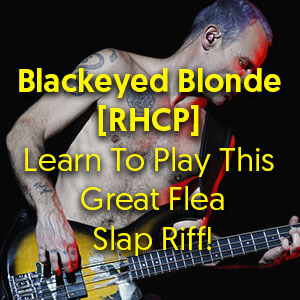In this lesson we’ll be looking at how to play slap triplets like Marcus Miller, Victor Wooten and Mark King. I’ll be working through 4 different techniques for creating those fast triplet fills and solo lines.
Main Riff
You might be aware of triplets in their usual sense – basically three notes being played in the space you’d normally play two – but in slap bass, they are often used to create fast, percussive lines that add extra rhythmic flavour to basslines. In this case we’re going to use them to construct fills to augment a fairly standard bass groove.
The main groove is in A Dorian, and played like this. Hopefully this part won’t pose too much of a challenge!
Practice Track:

Fill #1
Played at full speed in between the main riff, this fill might sound a little daunting. But if we look at it in isolation, you should find it possible to break down into mini patterns in clusters of three. Learn them each individually at a slow speed until they feel natural under your fingers, then move to the next one.
This is one my best tips to learning a long, complicated line. Breaking into smaller chunks that you then string together can make a lot of difference to your ability to master such bass lines. Look out for the nice slide into a chord that ends the run – I think it’s a really nice chordal tone for this line. If you’re comfortable around your modes, you can use the same technique and basic pattern to create your own lines based on this rhythmic pattern.

Fill #2
This fill uses ghost notes to create more of a sextuplet feel. Again, this might sound complex and intimidating at full speed in context of the riff, but in isolation you should find it fairly easy to play at a slow speed. These exercises are all about building up a muscle memory for these short runs of notes, and will enable you to build up speed with practice.
Again, this basic pattern can be played anywhere on the neck – and it’s the sort of thing you can use to create really interesting fills to liven up your bass playing.

Fill #3
This continues the basic idea of these fills by combining three rapid triplets in succession. I find keeping a relaxed hand position – my fingers almost ‘dangling’ over the scratch plate – works to keep my thumb almost parallel with the strings. This for me makes these kinds of line easier to play – but by all means find which type of hand position works best for you.

Fill #4
This final little fill is very reminiscent of the kind of fill you find on Mark King’s basslines for Level 42. The extremely staccato feel is helped along with a pop and a muted palm slap. A lot of people find it hard to play a muted palm slap without playing an actual note as opposed the percussive thud we’re actually after. This is why I put a lot of emphasis on having a relaxed hand that comes from home position.
It really is all in the hand action.
One mistake I made early in my playing was trying to rush to get to this kind of speed, trying my best to be Stu Hamm. Much, much better if you learn to play it at a speed you’re comfortable with until you have an instinctive muscle memory for it. Then you’ll find it much easier to pick up the tempo.














Thanks Mark, these are great exercises. I’ve been working my way through the walking bass course and this was a welcome break from it before I jump back in to finish the course. As usual you’re always adding more value to TalkingBass.
Superb lesson as always, I’ve learned so much from you over a protracted time as I can’t play as much as I’d like to, but you make it super-easy to sound like an accomplished bass player!!!
Mark, I’ve played bass for 35 years, and only recently decided I wanted to add funk to my daily playing. Odd? Sure. But I am really impressed at how easy you are making picking this style up. You’re a great teacher and I am enjoying learning from you, immensely. Well done!
my g doesnt ring like that its more of a pingy/thud if that makes sense. so i cant get it to sound right
can’t get same sound and same speed of that first fill.. quite stuck for thee moment :-(
Where is the backing track? I went to SoundCloud Through the link and it says you have not an added anything?
Hello Mark. I am currently enrolled in your Slap Bass Course Vol 1 and Vol 2. There is a particular 4-string electric jazz bass artist named Brian Bromberg who performs a song titled “Is That The Best You Can Do?” from his CD “Thicker Than Water”. I enjoy the 8-measure introduction, especially those triplet flourishes in the eighth measure of the introduction just prior to where the rest of the band joins in.
Is it possible for you break down that riff in the first eight measures of that song?
Best Regards,
Joseph Mallett
Great stuff Mark. I’m a beginner at the “slap” and that thumb thump is a good one. I worked on it for about an hour and finally got it. Ready to add a pluck or two. Thank you!